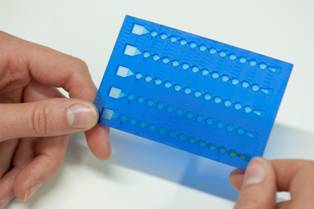Mobile platform for fast sepsis diagnosis
6 Jan 2011
A new credit-card-sized diagnostic platform being developed at the Fraunhofer Institute for Cell Therapy and Immunology will be able to diagnose sepsis in as little as an hour.
Currently analysis can take up to 48 hours to detect the potentially fatal blood poisoning.
In Germany 60,000 people die every year from some form of sepsis, almost as many as from heart attacks. Patients arriving at an intensive care ward with blood poisoning only have a 50% chance of surviving. One of the reasons for the high mortality rate is the fact that patients are not correctly treated due to late diagnosis.
The diagnostic platform, called MinoLab, will consist of a plastic card the size of a credit card that contains microfluidic circuits that pass the blood sample through a series of reaction chambers. The card is inserted in an analysis unit smaller than a notebook to provide the results.
The system is based on magnetic nanoparticles that dock onto the cells to be studied in a blood sample and run through the system fully automatically using magnetic force. At the end of the process, the diagnosis is made with magnetic sensors.
MinoLab is presently being developed in a project funded by the German Federal Ministry of Education and Research by the Fraunhofer Institute for Cell Therapy and Immunology (IZI) in Leipzig, Germany, in collaboration with Magna Diagnostics, a company hived off from the Fraunhofer Society. Other project partners are the Fraunhofer Institute for Reliability and Microintegration (IZM) in Berlin as well as the companies Siemens, Dice, microfluidic Chip Shop and the Austrian Institute of Technology.
Dr Dirk Kuhlmeier, a scientist at the Fraunhofer Institute for Cell Therapy and Immunology, explains how all that works: "After taking a sample of blood, magnetic nanoparticles bind themselves to the target cells in the blood sample through specific catcher molecules.
"We then use a simple magnet to transfer the particles onto the plastic card along with the pathogens and move them through various miniaturized reaction chambers which is where the polymerase chain reaction takes place. This is a method for copying even the smallest DNA sequences of pathogens millions of times.
"After it is copied, the nanoparticles transport the pathogen DNA into the detection chamber where a new type of magnetoresistive biochip can identify pathogens and antibiotics resistance.
"All reactions starting from sample preparation through isolating the target molecules right down to documentation are carried out without any contact and fully automatically."

A model of the reaction chambers
This means that routine operation is made much simpler for the laboratory technician and it reduces the risk of contamination from bacteria introduced from the environment that set off false alarms. But there is another benefit, as Dr Kuhlmeier explained: "We not only save time with the combination of magnetic nanoparticles in a new type of micro-fluid. Miniaturization means we also save on expensive apparatus."
However, Kuhlmeier added, “It will be another two years or so until we are able to produce a prototype of the diagnostic platform."
Platform technology is not only suited for sepsis tests. It will be able to back up doctors in hospitals and private practices answering a wide range of molecular biological issues ranging from genetic predisposition right down to cancer diagnostics.